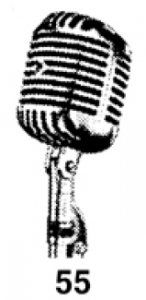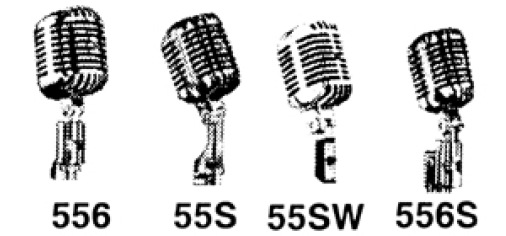Submitted by Bob Paquette
October, 2001
Shure Brothers introduced their model 55 Cardioid unidirectional microphone in 1939. The term Cardioid referred to the heart shaped pickup pattern of the microphone. Up until 1936 all microphones, except the ribbon microphone, had omni-directional pick up patterns, which meant that they picked up sound from all directions. The cardioid pattern had full pickup from the front, reducing pickup as you went around the sides, and minimum pickup  at the rear. The ribbon microphone had a bi-directional or ‘figure eight’ pattern. It had maximum pickup from the front or back, and no pickup from the sides, top or bottom. All the cardioid microphones used two microphone elements to produce this pattern. The Shure 55 did it with one dynamic element using their ‘uniphase’ principle.
at the rear. The ribbon microphone had a bi-directional or ‘figure eight’ pattern. It had maximum pickup from the front or back, and no pickup from the sides, top or bottom. All the cardioid microphones used two microphone elements to produce this pattern. The Shure 55 did it with one dynamic element using their ‘uniphase’ principle.
The 1939 model 55 could be purchased in three different impedances: 55A (30-50 ohms), 55B (200-250 ohms), and 55C (100,000 ohms). All these microphones had a satin chrome finish. The grille cloth was sienna brown at first. Later they used royal blue or black. The royal blue seemed to be used the most and had a tendency to fade, depending on how much bright light it was subjected to. From blue it faded to magenta and then to various shades of pink. All these microphone elements were internally shock mounted with springs and rubber. The frequency response was 40-10,000 hertz. The stand adapter was swivel mounted, drilled, and tapped for 5/8″ x 27″ stands and equipped with an MC3F Amphenol connector.
In 1940 Shure introduced the 555 Unidyne for broadcast and recording. This was the same as the 55 except for the swivel stand mount which had an additional shock built into it. It was also available in three impedances: 555A (30-50 ohms), 555B (200-250 ohms), and 555C (10,000 ohms).
In 1941 the 555 was superceded by the 556 super cardioid microphone which was twice as unidirectional as the cardioid. It also was available in three impedances as the 556A, 556B, and 556C.
In 1942 the 55V was introduced as a voice unidyne – tailoring the frequency response for hi-quality voice and singing applications. They rolled off the low end to give them a 100 – 10,000 hertz frequency response. This microphone was also available in the three impedances as the 55A, 55B, and 55C.
In 1950 they modified the rear shell and added a three position impedance switch. From that day on the 55 became a multi-impedance cardioid. They also listed the frequency response as 40 – 15,000 hertz.
In 1951 Shure introduced the new small unidyne featuring the new unidyne II microphone element. The microphone cage was reduced from 4-7/16″ H, 3-3/16″ W, and 3-9/16″ D to 3-15/16″ H, 2-3/16″ W, and 3-1/16″ D. The model number became 55S (s for small). The frequency response was 40 – 15,000 hertz.
In 1962 Shure introduced the 55SW. The swivel stand adapter was modified to house an on/off switch, and the grille cloth was changed to black foam. The foam grille cloth deteriorated in a short time and a replacement set could be purchased.
In the late 1970’s, the multi-impedance switch was eliminated and the microphone had two impedances… low and high. To change the impedance you had to remove the switch assembly and make the change internally. In 1988 the microphone element was changed to use the same microphone element as the SM48. This model became the 55SH.

